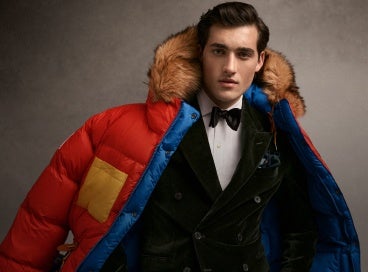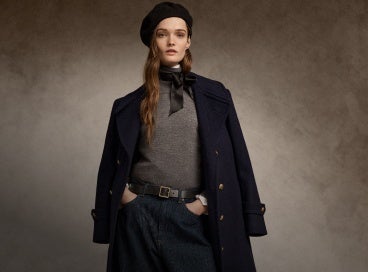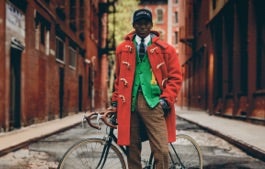
The RL Q+A: Shantell Martin
The artist on her latest mural in collaboration with Ralph Lauren, her personal style, and what’s next in 2022Known for her signature black-and-white compositions, artist Shantell Martin grew up in the Thamesmead public housing complex in London. As a child, she would capture the world around her by creating stream-of-consciousness drawings with a pen marker and went on to graduate from Central Saint Martins with a degree in graphic design. She then got her start by live performance drawing during DJ sets in the nightclubs of Tokyo, before moving to New York City in 2008. Exploring ideas ranging from intersectionality to identity, her large-scale paintings—chock-full of wordplay, faces, and stick figures—have been displayed at MoMA, the Brooklyn Art Museum, the Whitney, and the Albright-Knox Gallery. She’s also collaborated with the New York City Ballet, filling Lincoln Center with her graphic canvases, and now has choreographed her first ballet, called Kites, opening at the Boston Opera House this March. Equal parts painter and philosopher, she is constantly pushing the parameters of the art world with her monochromatic line drawings, not to mention bringing her uninhibited, whimsical style to new mediums.
We sat down with Shantell to discuss the creative process behind the latest mural she designed in collaboration with Ralph Lauren, her own personal style, the artists inspiring her now, how her art has evolved, and what’s on tap next in 2022.

Tell us a bit about the new mural in Brooklyn.
The design inspiration was in honor of February’s Black History Month. I wanted to create a piece that celebrated Black cultural icons and looked at several different things simultaneously, and one of its main themes is a reflection of the power of the written word. I put simple but profound quotes and words in the mural, which is something I do a lot of in my own work. In this piece, I have included four quotes from Nella Larsen, Audre Lorde, Maya Angelou, and James Baldwin, who are all in their own right really incredible poets and writers—and who see or who saw the power of the word.

What made you choose these quotes specifically?
The first quote I chose, “spiritual beauty,” is snipped from Nella Larsen, who, like me, is biracial. I see myself in her as someone who’s half-white and half-Black, and I really relate to her writing. She wrote a book called Passing, which spoke about how there is a spectrum to color—and how if we continue to make it very black and white, then we have to choose and create sides. But if we have to choose, then there isn't room for evolution. I also added James Baldwin’s quote, “If I can, I may.” I like the word may because it implies freedom—and it is well-wishing. It’s a word I use a lot in my work; my middle name is actually Mayu. I wanted to include writers that perhaps we’re not all that familiar with too, like Audre Lorde. She said, “I want to be recognized.” You know, I just want to be seen, not as this or that, but just to be recognized—as human. And then there’s a great quote from Maya Angelou: “If a human being dares to be bigger than the condition into which she or he was born, it means so can you.” I love that idea because it feels so universal.

How did you incorporate these quotes with your own creative process and iconography?
I integrated those inspirations with the classic Shantell Martin drawings. I have these characters and simple faces I often use in my illustrations, and they're always in conversation or in dialogue with each other as well as with the viewer. There’s also an array of stick figures; they’re holding each other up, they’re helping, they’re constructing. They keep the integrity of the word and the mission that they’re on, which is to keep everything and everyone together. Then I added references to cities and landscapes, which are about building futures and understanding the foundation that things are built upon. The language of the iconography I selected reflects these ideas, but the piece is ultimately meant to be playful and uplifting and accessible. I feel that is how you can really communicate with people—and inspire them to think about something, do something, look up something, or try something new.
What impact do you hope the mural will have on its audience?
I wanted to create a piece that felt fresh and energetic and open, and I’m always drawn to the simplicity of things. I believe that if we’re all creating or drawing or questioning, then the world will be a better place for everyone. My hope is that the piece will inspire that within the people that happen to walk past the mural or see it.
The scale of the piece certainly makes an impact!
Yes, it ended up bigger and bolder than I’d imagined! For me, it’s nice to see my work on that scale because in my mind that’s how it’s meant to be seen. The work is done using a thin brush and black acrylic paint on a primed wood surface, as it was too cold for spray paint to dry in the freezing weather. I hope it brings out the beauty and the knowledge that transcends race and can empower anyone to achieve their dreams.
Switching gears a bit, how would you describe your personal sense of style?
I would say my personal style mantra is that it needs to be comfortable. That doesn’t mean it needs to be completely casual, however. For years, I’ve been wearing these crisp white oxford button-down shirts—I’m still able to move in them and draw in them or be as flexible as I need to be. But most days, you’ll find me in a T-shirt, trainers, and jeans. If I need to smarten it up a bit, I’ll pop on an oxford. Without a uniform, there’s so much pressure to change things up, so I just keep it simple.
How has your style evolved over the years?
It hasn’t! I’ve literally dressed the same way since I was a child. I wear the exact same things I wore when I was 10 years old … and I’m still going strong! But as an art student at Central Saint Martins, I definitely spent way too much money on jeans and cool T-shirts.
What drew you to collaborating with Ralph Lauren?
Ralph Lauren is one of those brands that you’ve always been aware of, whether you've owned it or not. It’s iconic and it has such a distinctive identity. Personally, it’s a brand that I’ve had a relationship with since I was a child. It always represented a bold but classic style, but I love how his pieces are not stuffy but rather more relaxed.

What comes to mind when you think of Ralph?
If you picture someone who truly represents American style and the American dream, Ralph Lauren is really a perfect example. Ralph Lauren is a self-made brand—started by one man that had a vision and has now created this whole empire. I think stories like Ralph’s are very human and relatable. Once you start to look behind the history of a brand like his, it’s very inspiring to me.
What artists should we be following right now?
Good question! At the moment, I’m enjoying Kristin Kim’s work, as well as Kristjana S Williams. And, actually, Janet Echelman—she’s an artist from Boston who does these big, beautiful, draped nets. There was one in the San Francisco airport.
You recently dropped a collection of NFTs. How do you feel about the state of the art world right now?
I did! I think NFTs are interesting because before they came along, you had all these freelance artists and illustrators, but nobody saw their work. They didn’t have an outlet or a platform to put it out there. Now we have a ton of people who are creating communities and some of them are even getting their work sold and resold. I think that’s a really great thing.

What’s up next for you?
Right now, I’m very excited because I am about to head to Boston for the world premiere of the first ballet that I’ve ever choreographed. It’s called Kites and will be playing from March 3rd to March 13th at the Boston Opera House. I’m doing the set design, as well as everything from the costumes to the choreography.
I’ve spent the last few years studying how to apply my drawing to movement and dance. I am now also part of their bigger initiative, called ChoreograpHER, where they commission women to come in and create new pieces. So, principal dancer Tiler Peck did a piece, as did Melissa Toogood from Merce Cunningham Studio and Lia Cirio from the Boston Ballet. They're such incredible and inspiring women.
I’ve also been making my own music on SoundCloud. I have a bunch of albums out there. I never play the same thing twice and it’s kind of improvised like my art, but there’s some structure.
How wonderful! Anything else?
The ballet has been a big one, but I’m also excited about working with Critical Mass. I founded an artist-in-residence program with them called CM: AIR, the core of which is about creating better relationships when brands work with artists. We hold roundtable discussions with people from the industry and share resources, pinpoint the problems and the holes in the floors, and come up with solutions. At SXSW, I’m going to do a panel this year with Val Carson from Critical Mass. I’m really happy with that program because I believe it can have a big impact on future artists. This initiative will hopefully make that change even more global. I always try to leave things in a better place for the next artist that comes after me.







